Inland waterway businesses and boat owners are coming together to help the Forces Vets Afloat Project restore a boat so it can be used and enjoyed by British forces veterans. Founder and boat owner Andy Flint set up the Project in July 2021, and it is on track to send its first boat to the Veterans Support Association.
Read More
Yearly Archives: 2021
boat internet
boat internet
an introduction for the non technical
This article contains links to other websites - canalsonline.uk takes no responsibility for this external content or use of these sites. This article also lists a number of specific products; the author has no connection to these companies and there has been no endorsement or payment for the selection - other products are available. All information in this article is from experience and public sources but no liability is taken for your decisions! One last note; this article is intended as an introduction for a non-technical audience so please don’t email me commenting on lack of information about Signal-to-Interference-plus-Noise-Ratio or automatic LTE frequency selection. Do however get in touch if you think I’ve got something very wrong 🙂
Whether you use your boat on high days and holidays, spend only the summer months aboard or live on board all year round, a common requirement of the 21st century, along with a working engine, a hull that isn’t leaking and a loo of some variety, is access to the Internet.
I work in IT or Information Technology - a term which covers a multitude of sins - and in 2018 started working and living full time afloat. So long as I could access the Internet then I could work on the machines located anywhere in the world so why work in an office? And more importantly - why not on a boat?
“Using an LTE capable endpoint device, connected to a mobile network providers national infrastructure over the 800Mhz radio frequency range, it is possible to create an 802.11n local area network to access a shared local resource to multiple devices…”
…and in that one sentence you may see one of the problems! Being charitable you could say that IT people have been forced by the complexities of the technologies available to us to create a lexicon to effectively communicate together. Those less charitable say we’re no better than quack doctors in using jargon to deliberately obscure and baffle those “not in the know”! The truth is I suspect somewhere in between. Add a marketing department into the mix and we’re all in trouble!
So the following is an attempt to provide a few unbiased recommendations based on personal experience of what you can use to access the Internet from a boat, tips on getting better speeds whilst hopefully explaining some of the jargon we use.
Getting to the Internet
If you’re just interested in the bits and bobs you might need to get Internet access then jump to the next section… otherwise read on!
The first thing we need to do is define the word “Internet”... which is quite tricky without falling down the jargon rabbit hole! The Internet isn’t one “thing” (as joked about here ) but instead a collection of services provided by multiple interconnected networks operated by different people, organisations and countries and states.
We use an “Internet Service Provider” (or ISP) or Mobile Provider to give us a gateway into these inter-connected networks we call the Internet.
The most obvious difference between getting “Internet” from a boat compared to a house is that, with a few notable exceptions, BT, Virgin Media and the like will refuse to install broadband using a cable onto a boat. This forces us to use radio waves rather than a physical cable to carry requests to and from the Internet so we will get access from a mobile provider - think Three, EE, O2, Vodafone and co.
Radio waves are split into frequency bands - which I find easiest to think of as the different colour bands of a rainbow - with different services being provided in the different bands [1]. There are frequency bands used by the emergency services’ radio system, frequency bands used for satellite TV and another for digital TV and some that are used for “Wi-Fi” (more on that later). But the most relevant frequency bands for “getting Internet from a boat” are 3G and 4G (and maybe if you’re in the right area 5G) which are most commonly associated with mobile phones.
You’ve probably heard of 3G and 4G because your phone uses them to get access to the Internet. 3G (the G stands for Generation so it is 3rd Generation) was the first widespread technology to provide sufficient speeds to make mobile Internet worth having. This has been widely replaced or augmented with the LTE service (Long Term Evolution) or as it’s more commonly known thanks to the marketing people - 4G - which was designed to be faster and more flexible and resilient than 3G.
 Your phone (which I’ll also refer to as the “customer endpoint”) connects to your mobile provider's nearest operational mast which in turn (eventually) connects through to the “Internet”. This miracle of modern telecommunication engineering is possible because the frequency bands are spread out for the different services (TV, Radio, Mobile Internet, etc) and within the allocated frequency band for 3G and 4G there are further divisions allocated to the different mobile providers [2]. This limitation on the frequency bands available to 3G and 4G means that mobile providers paid a lot for their allocated slot - in 2012 the Government was hoping to get £3.5 billion from the 4G frequencies auction! [3]. Fact of the day - the auction of the 4G frequency band (800Mhz) was only possible because the old analogue TV service, which was previously using it, was turned off [3]. 5G is the next faster, and better mobile service (depending on your viewpoint on its safety!) although the rollout of the service is taking some time.
Your phone (which I’ll also refer to as the “customer endpoint”) connects to your mobile provider's nearest operational mast which in turn (eventually) connects through to the “Internet”. This miracle of modern telecommunication engineering is possible because the frequency bands are spread out for the different services (TV, Radio, Mobile Internet, etc) and within the allocated frequency band for 3G and 4G there are further divisions allocated to the different mobile providers [2]. This limitation on the frequency bands available to 3G and 4G means that mobile providers paid a lot for their allocated slot - in 2012 the Government was hoping to get £3.5 billion from the 4G frequencies auction! [3]. Fact of the day - the auction of the 4G frequency band (800Mhz) was only possible because the old analogue TV service, which was previously using it, was turned off [3]. 5G is the next faster, and better mobile service (depending on your viewpoint on its safety!) although the rollout of the service is taking some time.
So… your phone is connected to your mobile providers nearest mast using 3G or 4G and from there off to the Internet - all is good with the world! Right? Well… no...
The mast that you’re connected to has limited and finite bandwidth (think of it as a pipe that can only transport so much water at one time) to provide access to the Internet, so as the number of customer endpoints (e.g. mobile devices) connected to mast increases the amount of bandwidth available to you decreases because it is divided between the endpoints connected to the mast. This is why you can be at a festival and your phone can show full signal but you can’t access the Internet - all of the bandwidth available to your connected mast is used up!
And if you happen to be really far away from the nearest mast then the signal - which is measured in decibels like sound - will be reduced, meaning a further drop in speed.
To add to this tale of woe there are things which can interrupt, degrade and block your signal to the mobile provider's mast, such as buildings, hills, other electrical devices broadcasting on nearby or overlapping frequencies (including as I once found, an airport’s landing radar system!) and this is before we get to one of the most limiting factors for many of us - the metal hull of the boat itself which has similar properties to a faraday cage! It’s a miracle it works at all!
So how do we counter these problems to get the best signal possible which in turns gives us nice speedy Internet access?
The first way is to use an antenna fitted to the outside of the boat on a retractable mast - the higher up the better - to give you a more direct connection to the mobile providers mast.
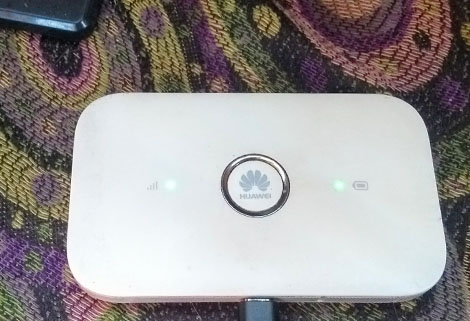
As an Antenna can’t be connected to a mobile phone we’ll swap the phone for an “LTE/4G router” which is a box into which you insert a SIM card (just as you do with your phone) which takes the mobile signal to and from the mobile providers nearest mast and gives you Wi-Fi inside of the boat. Which then begs the question.. what is Wi-Fi?
Wi-Fi (or the IEEE 802.11 protocol if you’re feeling technical) is another way to transmit computer data without a physical cable and instead using radio waves. Unlike 3G and 4G it is used to connect local devices - that is to say your phone, computer, printer, TV, etc to a router which then sends the data off to the Internet using the 3G/4G radio signal. Like 3G and 4G it has dedicated frequency bands - 2.5Ghz and 5Ghz - but it runs at lower power because it doesn’t have to go over the same distances.
So with all this information we could now summarise your best chance of getting Internet access from a boat as:
-
- Your laptop/printer/TV connects using Wi-Fi to your LTE/4G router
-
- Your LTE/4G router uses an inserted SIM Card and transmits radio waves through the external antenna using 3G or 4G frequencies to connect and send data to your selected mobile providers nearest mast.
-
- So long as there is enough bandwidth available to the mast, your data is sent on to the Internet.
Changing frequencies
The second way to get faster Internet access is to change the frequency you’re using - this isn't as bad as it sounds so read on!
By default phones and routers are configured to automatically use the best signal they can find. In practice this means, if it’s available, devices will select the 4G service if it’s available which is considered “faster” than 3G, even if the 3G service in that particular location is better! This automatic selection doesn’t take into account how contended (how many people/devices are on) that frequency/service and other things that effect one frequency band over another as mentioned above. Because of this I’ve often found that the 3G service can provide a faster service to the Internet than the 4G service!
To test the “speed” you’re getting to your device you can use one of the many free services such as https://broadbandtest.which.co.uk. Websites like this will return an indication of the “speed” you can download (how quickly you’re getting data from the Internet), and upload (how quickly you’re able to send data to the Internet). The figure to look for is Mbps (Megabits per second) - the higher the number the quicker your connection. I would recommend using the same website to test your speed each time so you’ve get a consistent baseline to test against - different “broadband speed testers” will have different responses based on their own Internet access and a hundred other mitigating factors.
This change, from using 4G (or auto) to 3G, would be done on the settings page of the LTE/4G router. Because of the many different models available it’s impossible here to give instructions on how you would change this setting but the manual should tell you how to get onto the settings page and from there it’s a case of searching until you find a drop-down box that says Auto, 4G only, 3G only, etc (or similar) then saving the setting. There are often YouTube clips for the most popular models so that’s another good source of information on how to do this.
I can give you an example of the difference in speed you can get between 3G and 4G where the 4G service is seemingly highly contested or less available. In Armitage on the Trent and Mersey Canal the 4G service returned around 0.6Mbps - which is virtually unusable for most modern Internet requirements such as watching TV or videos online or working. The same test done using the 3G returned 21Mbps which is one of the best speeds I’ve found outside of a city or very large town! That said, these services along with the contention is constantly changing so just because it was better on 3G one week doesn’t mean that 4G won’t be the better service the next week - when you moor up do a quick test on both using the online test website to check.
Finding good signal by map...
The third way to improve your Internet speed is to use your mobile provider’s website to check what the signal is like in an area and moor up where the signal is reported to be strongest.
All of the major mobile providers (e.g. Three, EE, O2, Vodafone, etc) have maps like this - website/Discover/Network/Coverage - which display what the signal in a specific area is expected to be. It’s not always accurate but if there is a “dead” area of no signal on their map and you need to do some work then it’s probably not a good place to moor up!
Mast hunting...
The last resource, although it’s debatable exactly how useful it is, is to use a website like https://www.cellmapper.net/map# which displays the exact location of mobile masts. A word of warning though - the information on sites like this isn’t always up to date as the data is not provided by the mobile providers themselves.
Internet TV
For many years the only option for getting a TV signal on a boat was to use an antenna which had to aligned to the nearest TV mast when you moored up. Internet TV has really taken off in the last few years, especially with the investment the big channels have put into their streaming services (such as BBC iPlayer) and it’s now a viable option to only use the Internet rather than a TV aerial (we do!).
 The options here are either to use a “smart” TV such as a Cello Android TV which runs on 12v and directly connects to your boats Wi-Fi, or use a “non-smart” 12v TV and plug in a “streaming player” such as a Roku dongle which connects to your Wi-Fi for the Internet and a HDMI port on the TV.
The options here are either to use a “smart” TV such as a Cello Android TV which runs on 12v and directly connects to your boats Wi-Fi, or use a “non-smart” 12v TV and plug in a “streaming player” such as a Roku dongle which connects to your Wi-Fi for the Internet and a HDMI port on the TV.
Yes… but what do I actually need to get???
The simplest way of getting Internet on your boat is obviously to just use your mobile phone which has 3G/4G (and maybe 5G) capabilities. Where the signal is weak though, due to the many reasons listed above, you can find yourself hugging the window, cursing and adding to life's frustrations - not what you want when you should be chilling out (you’re on a boat after all!).
That said if you’re not on your boat often and don’t want to invest in more expensive technology then you can use your phone as a hotspot to provide Wi-Fi access to other devices such as computers and a TV. Any devices connected via Wi-Fi to your phone hotspot share the 3G/4G data service that your phone uses. Beware though - this can eat up all of your data allowance on your phone VERY quickly!
The way you’ll enable the hotspot feature on your phone changes according to what type of device you have but these articles will broadly help:
If you’re planning on needing Internet access more frequently - or a more stable connection is required - then the next step is to invest in the following equipment:
-
- An external Antenna
-
- A “data SIM card” from a mobile provider (possibly even two SIM cards from two different mobile providers to give you the best chance of getting to the Internet)
-
- An LTE/4G router (note: some mobile providers sell this device as a bundle with a data SIM contract - see below)
The antenna
As you start looking for advice on the Internet about the “best” antenna to get it quickly becomes a minefield of terms such as MIMO, Directional, Omnidirectional, Antenna gain and radiation patterns!! If you’re interested in all of these terms then I’d recommend taking a look here . If terms like these make you start to go cross eyed (and I really don’t blame you!) then I will say:
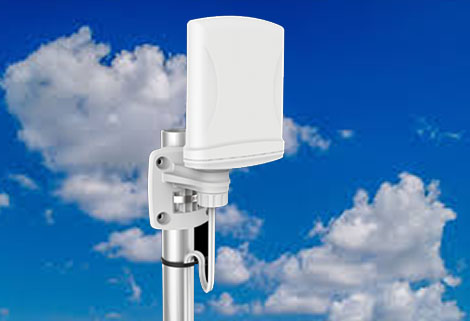
Select an outdoor antenna - you need to be outside of the boat to get the best signal.
-
- The connector on the end of the antenna you select has to match the input to your router. The most common connector seems to be the SMA type but check the specification of your router before you buy!
-
- Check the length of the cable provided with the antenna - it needs to be able to reach back inside the boat to where your router will live!
-
- If you’re happy on taking a recommendation then the one I’ve used for three years is the Poynting XPOL-1 which is available from many online UK retailers. I’ve accidently dropped my antenna in various rivers and canals and it’s lived to tell the tale and I’m increasingly seeing this model appear on narrowboat roofs around the country.
The antenna is going to get better reception the higher up it goes but you’ll need to be able to take it down to fit under a lot of tunnels and bridges (I often forget so you’ll see me scurrying down the gunnels to take it down after we’ve set off!). I use the Kuma antenna mount that attaches using a strong magnet to the roof (so no permanent fixing required) with a pole that attaches to the antenna which is secured using a jubilee clip.
The Poynting antenna comes with two 5m cables and one of the challenges is getting the cable back inside the cabin. Some people stick the cables through a handy mushroom vent but I chose to drill two holes in the forward bulkhead to feed the cables through. I’ve used a “solar panel feed gland” and plenty of Sikaflex to make sure that no water gets in through the holes.
The SIM
All of the major mobile providers have a “data sim package” available and whilst the options are boggling it’s very much a personal choice which you select. I will say that you want to look for a package that is:
-
- Affordable - no point in breaking the bank huh?
-
- Has the most data allowance for the best price
-
- Comes from a mobile provider that gives you the best signal in your area if you stick in one place, or a frequently repeated area.
These packages are normally advertised by the data allowance which is normally described in gigabytes (GB). Basically - the higher the number the more data you get but also the more you’ll pay. It’s difficult to say how much data you’ll use but to give you a (very) rough idea:
We use the boat Internet for:
-
- TV (I’d say around 7 hours a week on average at a guess)
-
- Work (30-40 hours a week)
-
- General browsing and Internet radio (10 hours a week?)
According to my last statement we used 50GB of data last month but sometimes that goes through the roof and we accidentally use over 100GB - some of this depends on the signal quality as bad signal leads to lots of retries which increases the use.
If you’re planning on only cruising in a specific area then check out the mobile providers Network Coverage maps (available on their websites) as you may find one provider has better signal in your area than another.
We selected the Three mobile provider based on price, data allowance (we use the unlimited package after maxing out 100GB a couple of times!) and information from boating forums. I also have a backup SIM from Vodafone from my employer which I use when the Three network infrequently drops out or doesn’t have any signal.
We cruise around a fair bit of the network, the furthest points so far being Gloucester in the south west, Llangollen and Wigan in the north west, Shardlow through Stoke on Trent to the north and east of the midlands, March in Cambridgeshire to the east and Oxford being the most southerly point so far, and I’ve been able to work (and more importantly Em has been able to watch the TV and browse the Internet) in pretty much every mooring - with a few exceptions like Zouch on the River Soar where we had to move to Loughborough so I could start working again!
The LTE/4G router
As mentioned above, the router is the piece of equipment into which you’ll insert the SIM card. This device connects to the mobile network using 3G or 4G (LTE) and provides Wi-Fi inside of the boat to the TV, laptops, etc.
Many mobile provider’s data packages have an option to buy a router bundled in (often for the same or similar price of just the data package). The important things to look out for, whether you select this or get a different router, are:
-
- The antenna connection - make sure it a) has an external antenna connector and b) it’s the same connector as the antenna you’ve selected otherwise you won’t be able to connect the two together! Most commonly this is the SMA connector - the antenna will provide a SMA Male Connector (with a pin the in the middle) so you’d need an SMA Female connector (with a hole in the middle) on the router.
-
- The power requirements. The type of router that can connect to an antenna requires power (i.e. it doesn’t have it’s own internal battery which the smaller “routers” without antenna connectors sometimes do). As most boaters want to run everything off of 12v to save the overhead of running an inverter you’ll want to check that the router you select has a low power draw (i.e. less than 12v).
-
- A lot of LTE/4G routers have a very low power requirement but come with a 240v (UK) plug. Check that you can find a 12v adapter that works with the router you select before you buy! When we bought our router we purchased the 12v adapter that had a “cigarette” type adapter which I then chopped off and soldered to a fused switch on the wall.
Whilst it’s unlikely to be a problem, you may like to check that the Wi-Fi signal the router provides inside of your boat is usable by your laptop/phone/TV. Wi-Fi or 802.11 has a number of variants; b/g/n and frequencies (2.5Ghz and 5Ghz). Some routers for example could feasibly come with only 5Ghz 802.11n which some older Apple devices and laptops are unable to use. It’s unlikely to be a problem but it’s worth mentioning if you decide to select a more obscure router.
If you decide to not get the router from your mobile provider then there are a number of manufacturers that make LTE/4G routers. The one I chose is made by Teltonika Networks who have a single SIM option and a dual SIM option (this second option allows you to insert SIM cards from two different mobile providers which can then be selected in the configuration page of the router) I purchased mine from Eurodk. The Teltonika Networks LTE routers have a massive number of features but I found them easy to configure and there is a 12v adapter available.
As I’ve mentioned though there are a fair few manufacturers of LTE/4G routers so shop around for one that suits you.
One frequent “gotchya” when setting up a router that hasn’t been provided by the same company that provided the mobile data package (SIM) is the mobile providers APN selection. I’m not going to go into this here but if you insert the SIM and it doesn’t work then it could be the APN. Give their support team a call (yes… I know how painful this can be) and they’ll be able to let you know the values needed for your router.
Conclusion
As with pretty much everything, you can get a cheaper version of the same thing but it’s normally reflected in the quality! There are a bewildering variety of antennas and LTE/4G routers being produced by Chinese manufacturers and some of them are fantastic but there’s a lot that just aren’t worth “saving” money on as you’ll find they don’t live up to expectations or the advertised specifications.
I’ve listed the products above because I’ve been using them for a couple of years so don’t have a problem recommending them (I’m not being paid for listing anything so this is an unbiased view). At the same time I haven’t tested any other products out there apart from the Huawei B310 LTE router which was ok until it unexpectedly stopped working without warning one morning! Hopefully the information I’ve listed above will give you an outline of the questions to ask and what to look out for.
Whilst there are more options available to get Internet access from a boat such as mobile broadband dongles (which can't use an external antenna) and Satellite provided Internet I haven’t gone into them here because they’re either not as effective or have a higher overall cost than a LTE/4G router with an external antenna - but they should be considered for affordability and suitability for your requirements.
It’s also worth mentioning that you can do everything listed above and more and still end up in a spot with no Internet availability - it’s all part of the randomness of boating.
Perhaps the best thing about all of these things though, albeit the one that is most often forgotten about, is the off switch. Having Internet on the boat has given us the freedom to live on the inland waterways and travel (when not in lockdown!) but at the same time it’s great to disconnect and watch the world on the water go by.
[1] smartaerials.co.uk “Broadcasting frequencies used by TV Aerial, Radio and Satellite”
[2] 4g.co.uk 4G Frequency Information
[3] BBC “Will the 4G mobile auction meet the £3.5bn target?” 12-Dec-2012
twelve months on
twelve months on
my first year as a continuous cruiser
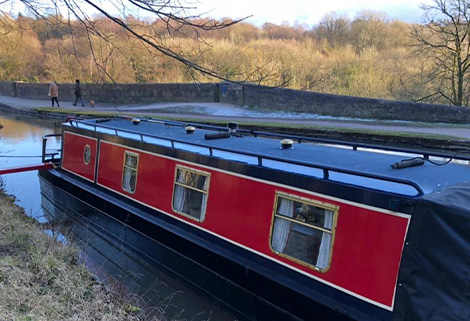 I bought Blackbird, a 40ft narrow boat just over a year ago and have just completed my first year as a Continuous Cruiser. It’s been a wonderful time (mostly)! I have enjoyed travelling through the inland waterways enormously. It has given me an appreciation of our nation’s industrial heritage in a way that no amount of reading or consumption of modern media technology ever could. I now know why the Black Country was so named, the importance The River Weaver played in the salt trade, I have learnt about the movement of coal and limestone along The Lancaster Canal and the connectivity between Cornish clay and The Staffordshire Potteries. I have experienced first-hand the power of The English Rivers, not just as forces of nature, but as the living veins of our earliest transport routes. I have also learnt a good deal of practical things that have helped me make living on board a pleasure, I am sure other boaters could add a their own advice….
I bought Blackbird, a 40ft narrow boat just over a year ago and have just completed my first year as a Continuous Cruiser. It’s been a wonderful time (mostly)! I have enjoyed travelling through the inland waterways enormously. It has given me an appreciation of our nation’s industrial heritage in a way that no amount of reading or consumption of modern media technology ever could. I now know why the Black Country was so named, the importance The River Weaver played in the salt trade, I have learnt about the movement of coal and limestone along The Lancaster Canal and the connectivity between Cornish clay and The Staffordshire Potteries. I have experienced first-hand the power of The English Rivers, not just as forces of nature, but as the living veins of our earliest transport routes. I have also learnt a good deal of practical things that have helped me make living on board a pleasure, I am sure other boaters could add a their own advice….
Condensation.
I was rather surprised at how much condensation could appear after just one night; even when the boat was reasonably warm. I now try to:
Warm the cold places of the boat by opening cupboard doors.
Wipe down the windows each morning with an absorbent cloth; as it prevents moisture getting into the window frames and causing rot.
Open the galley window a little when cooking.
Insulate, insulate, insulate! Everywhere you can.
Create airflow routes, I drilled holes in the board that supports the mattress and in the draw fronts under the bed. You can make patterns so the holes are decorative as well as practical.
Wood Burners.
 I have used open fires and stoves for 30 years and so am very familiar with the art of fire making. However, the stove on Blackbird is fairly small and making the most of the warmth has taken some thought.
I have used open fires and stoves for 30 years and so am very familiar with the art of fire making. However, the stove on Blackbird is fairly small and making the most of the warmth has taken some thought.
I always have a good supply of dry kindling and small logs to hand to get the fire going quickly after a cold day's cruising.
A dedicated bucket for ash and a small shovel are very useful.
Keep your eyes open for the wonderful local coal barges and stock up when you can. There are several different smokeless products available which burn at different rates and have different heat outputs. Try a few until you find the sort that works best in your boat.
My stove heats the space best when it is on long and low; I fill it up in the evening before I go to bed and turn the vent right down. Even if it goes out during the early hours of the morning there is enough heat to take the edge off the chill.
Forage for wood as you go, log it with a bow saw and store it somewhere to dry.
Make good use of the top of the stove to slowly cook a stew. I use a trivet under the pot to stop the bottom burning. It’s an ideal place to warm a kettle too.
Mooring
Angle mooring pins and position them well back from the bank, in wet ground they can pull sideways with the movement of passing boats and slip out, even when they are hammered fully in.
Use brightly coloured plastic bags around the tops of the pins to highlight their position to other towpath users. Sainsbury’s are perfect!
If you don’t have a piling pin, a normal long pin can be used. Position it vertically through the back of the horizontal piling and wrap the lines over the top and bottom of the pin before tying off on the dolly.
Learn to tie a few knots, a round turn and two half hitches, a canal man’s hitch and a clove hitch will all be useful.
Clothes
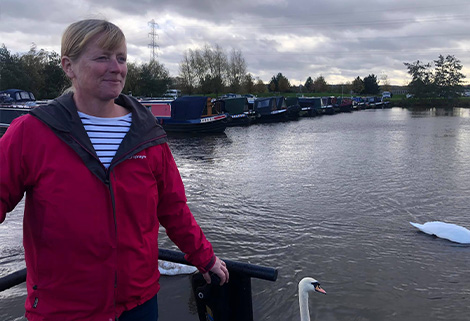 Be ruthless, chose what you really need and give the rest to a charity shop.
Be ruthless, chose what you really need and give the rest to a charity shop.
Pack the clothes that you aren’t wearing in vacuum bags, it will save space and keep them dry.
Slip on shoes are perfect for going in and out of the boat, especially when it’s muddy.
Fuel
Keep diesel tanks as full as possible, especially in the winter. Diesel bug lives in the water film between the air gap and the diesel layer. I had it in my engine and it clogged up my fuel filters. If you do get diesel bug it can be treated with products available in most chandlers.
A spare gas cylinder is a very useful thing! I buy mine from the fuel barge.
Engines
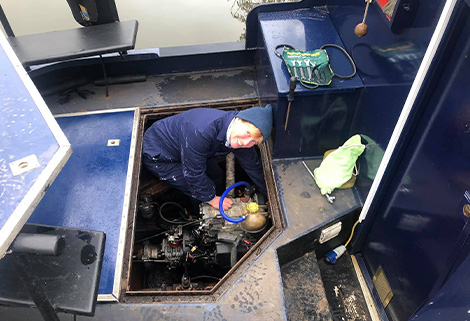 I knew very little about diesel engines a year ago, now I can change the oil, and filters, tighten and replace an alternator belt, monitor the coolant and oil levels and pack a stern gland greaser with grease. These are all surprisingly easy jobs, learning how to do them will save you money and give you confidence in your engine.
I knew very little about diesel engines a year ago, now I can change the oil, and filters, tighten and replace an alternator belt, monitor the coolant and oil levels and pack a stern gland greaser with grease. These are all surprisingly easy jobs, learning how to do them will save you money and give you confidence in your engine.
I have also assisted in replacing an alternator and removing a gear box that needed to be reconditioned. I really like engines now!
The weed box should be examined regularly especially in areas that have a lot of rubbish or vegetation in the water. I have been surprised by how little weed around the prop it takes to lose a lot of power. I have also learnt to know when there is a lot of weed on the bow by the sound of the engine.
Make a note of the part numbers for your filters and belts and keep some spares, you never know when you might need them.
Cruising
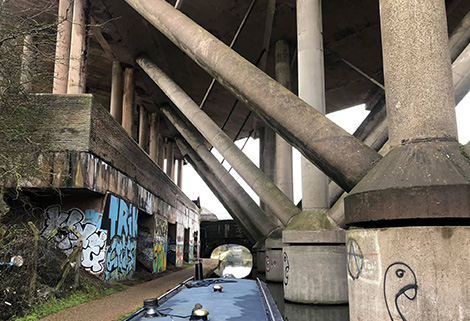 A guide book makes the journey richer as you can understand the history of the environment around you.
A guide book makes the journey richer as you can understand the history of the environment around you.
Go slowly, stop often and explore the places you pass through.
Talk to the people around you and hear their stories.
Security
Pick your mooring spot carefully, ideally around other boats. If you have to leave the boat for a while, there are several things you can do to deter would be intruders:
Place a pair of big, old boots just outside the door.
Set a battery powered radio to come on in the evening.
Twinkling fairy lights make the boat look as if there is someone inside.
I have met lots of interesting people both on and off the boats who have been so kind and helpful. There is never any shortage of advice! I have loved boating life and can’t wait for year two!
waterfowl
the diary of iris lloyd
waterfowl
I am very fortunate to be living opposite a bridge over the Kennet and Avon Canal, part of the High Street, in Hungerford. The Rose of Hungerford, a pleasure boat, is moored opposite my house, as are several other narrow boats. There is often activity on the water with the movement of boats, fishermen sitting for hours along the towpath, or the annual canoe race from Devizes to London. In the better weather, boat owners are busy cleaning their boats or they put foldaway chairs on the towpath and sit and enjoy a chat with their neighbours or have drinks and snacks out in the sunshine fore or aft. They are always ready for a friendly ‘Hello’.
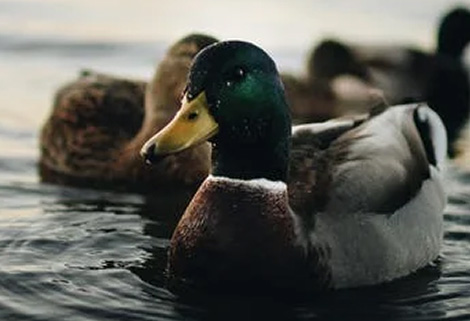 Another great pleasure in living by the canal is watching the waterfowl. There are always plenty of ducks, the males with their beautiful heads of green sheen, and if we are lucky, a flotilla of baby ducklings in the spring. Sad to say, the ducklings reduce in number very quickly and few survive to maturity.
Another great pleasure in living by the canal is watching the waterfowl. There are always plenty of ducks, the males with their beautiful heads of green sheen, and if we are lucky, a flotilla of baby ducklings in the spring. Sad to say, the ducklings reduce in number very quickly and few survive to maturity.
Parents and grandparents bring their children to feed the ducks. Feeding them with bread is not good for the canal, as it pollutes the water, and is not nutritious for the ducks, whose natural diet is seeds and greenery (try sweetcorn, lettuce, peas, or oats), but families have done this for generations and there is no way of stopping them.
As well as the ducks, there is an occasional coot or moorhen, and every summer half a dozen Canada geese make it their stopping-off point for a few weeks. They’re very visible with their smart long black necks and white bodies.
Then there are the swans. This year, one set of parents has been very much in evidence with their cygnets, as large as they are but with brown feathers, now turning white. When they first appeared, there were seven of them, but one disappeared. However, this male and female have been very good parents and have successfully reared the other six. They join the ducks to be fed, often leaving the water, which is very disconcerting for parents when the swans are as tall as their very small children and are not nervous of approaching a possible food source.
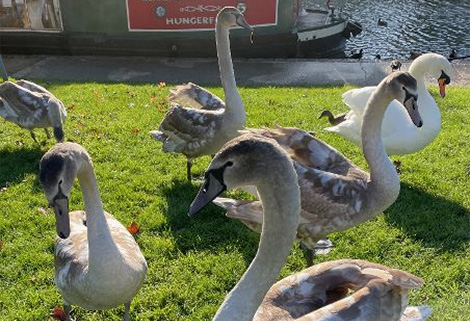
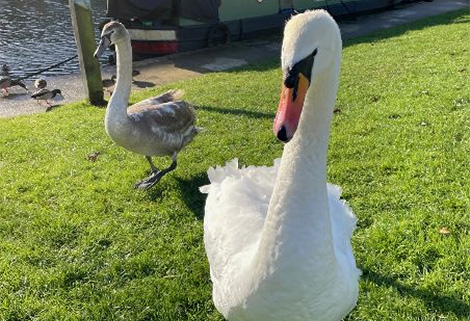
Sometimes they spring up onto the grassy bank on my side of the canal, flap their wings to dry off a little, then approach any visitors who are taking advantage of the sunshine by sitting on the wooden benches to eat their snacks.
They were there today, at the beginning of December, and we took some good close-up photos of them; obviously they thought that the mobile phone was something good to eat!
a strange day on the wey
a strange day on the wey
...a tale of detective work
When I left school at sixteen I didn’t have a lot by way of exams to speak of, so I went off to Kingston College of Further Education to get some more. With good marks in my City and Guilds electronics I set about working for a local company that made already obsolete equipment. I got bored and decided that there had to be something else out there. One afternoon, one of the guys at work spotted some of my doodles and suggested I could do evening classes in art. That was it! I’d be an artist so, armed with another couple of O levels from evening classes, I applied to Epsom school of Art and Design. To my surprise, I got in! This was all way back in 1977, when I lived at home and went on family holidays with my parents (like you do).
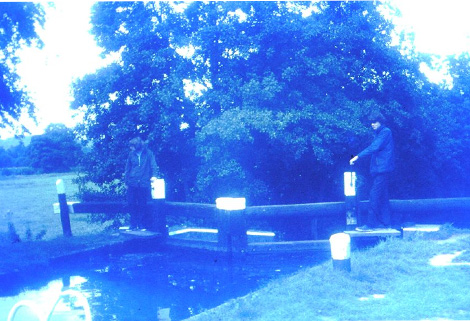
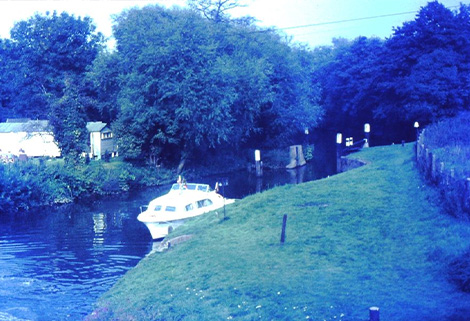
I hadn’t a clue that this was going to be one of the last holidays on the 26 ft Springer that dad had fitted out some years earlier. Waking up on a Wednesday morning, with average weather for the time of year, it seemed that nothing out of the ordinary was going on as we looked over the scenery near Worsfold Gates on the river Wey. Apart from there being a faster current than usual, all was well. During breakfast I decided to turn the radio on for a bit of music, only to hear that crowds had gathered outside some unspecified mansion and that the news reporter was broadcasting live.
“He was such a beautiful and wonderful person,” one onlooker said tearfully
“How will we ever live without him,” another cried.
OK, so something big had happened but nobody said where the mansion was or who it was that had departed this world there. The accents of those speaking were clearly American but they could have been there or in this country or basically tourists anywhere in the world where a mansion had been built. We carried on listening but the only information we got was that they would go back to the live broadcast sometime in the next hour. We were told the weather for the day, which we’d more or less guessed, but still not where or whom the news broadcast was about.


After a spot of watching the swans swimming to stand still in the current, I decided that it may be an idea to walk into the village and get a paper or at least ask someone. Whilst I was contemplating, a man from what looked like a live-aboard lifeboat conversion asked idly if we knew what was going on with the news. With this conversation overheard by another boat owner who was just as clueless as the rest, I decided it was time to make a move.
“I’d go to the village but I’m waiting in for someone,” the live-aboard owner said. “But you can borrow my bike if you don’t mind getting me a tin of tobacco when you’re there.”
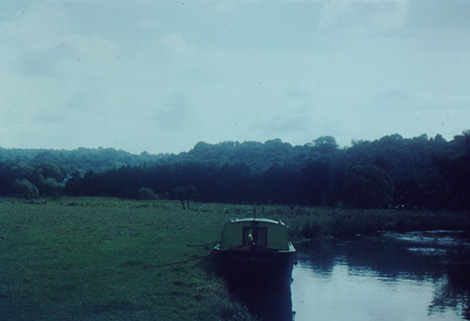 With money given for the tobacco, a couple of other orders written on a sheet of paper, I got directions to the village and set off on the borrowed rusty green Raleigh bicycle. It was pleasant riding along the route dictated to me, as the bleb in the tyre thumped the brake block with each revolution of the wheel, and I was beginning to wonder whether the thing would stay inflated when I arrived at the post office in Send village. Leaning the cycle carefully against the wall I bought the tobacco, some bread and other groceries and then asked for a paper that may tell me what the hell was going on.
With money given for the tobacco, a couple of other orders written on a sheet of paper, I got directions to the village and set off on the borrowed rusty green Raleigh bicycle. It was pleasant riding along the route dictated to me, as the bleb in the tyre thumped the brake block with each revolution of the wheel, and I was beginning to wonder whether the thing would stay inflated when I arrived at the post office in Send village. Leaning the cycle carefully against the wall I bought the tobacco, some bread and other groceries and then asked for a paper that may tell me what the hell was going on.
“Nothing in the morning edition,” the lady behind the counter smiled. “I’ve been wondering but, if you wait a few minutes the late issue is due. You can have one of them.”
With nothing much to do, I decided that a 20 minute wait was fine, and settled to looking through stationery and other bits and bobs. Whilst there I bought a small balsa model plane kit with the thought of building it during the holiday. It was a simple thing, powered by a rubber band and endorsed by the BBC. Their approval wasn’t really worth the ink used to print it as the device was really flimsy, making it unusable in anything but still air. With the purchase made, the papers arrived and I stuffed one into the handlebar basket of the Raleigh before heading off back to the boat to the accompaniment of the thump, thump, thump of the bleb.

“Did you find out?” I was asked on my return.
“No, I just got the paper and came back before I forgot which way to go,” I replied.
Finally the truth came out. The person in the news was none other than Elvis Presley himself, who had passed away the previous afternoon in Memphis. The swans didn’t seem bothered and there was no crazed outpouring of grief in the meadow. In the next chart show, the song, “Way Down” ceased its slow descent and shot to number one where it remained until after I’d enrolled at art school.
None of this has much to do with the River Wey and its general quirkiness as a navigation, but it is one of those moments that sticks in my mind, partly because of the location but also because of the event and the fact that, for most of a morning, nobody in that meadow had a clue what this big news event was.
All of these memories, like so many more have filtered their way through to my writings. My foundation year and first days at Sunderland Polytechnic are now shared by May Farmer in “Maze Days,” but as yet, the incident with Elvis has not percolated. It happened though, and I remember it as well as I remember spending hours rigging that model plane with cotton until it could fly in a hurricane. ©2021 Michael Nye
coping with extreme weather
coping with extreme weather
With the UK’s weather patterns becoming increasingly unpredictable, River Canal Rescue is advising owners how to manage their boats during extreme weather scenarios.
The emergency assistance and breakdown firm says the key to dealing with any situation is timing and balancing health and safety.
Managing director, Stephanie Horton, says: “In order to stop a vessel drifting onto land when water levels rise, position a scaffold pole or poles, or a boarding plank, between the boat and the river/canal side edge and fix it into position. This acts as a mooring post, preventing flood waters from floating the boat onto land.
“Alternatively use the engine to keep the vessel in position, so when the water rises, the power of the boat keeps it in deeper water. However be mindful that as the propeller is at its lowest point, it can easily be damaged if the boat does drift. These options are not advisable other than in emergencies and if you have the opportunity, moor in a lock as it provides some protection from flood waters.
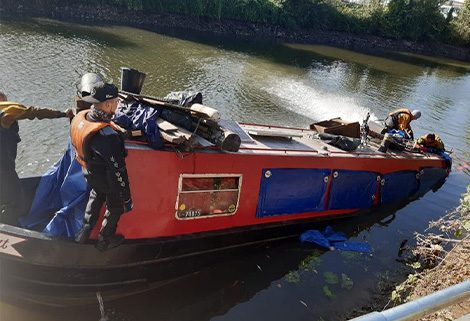
“If the boat has drifted, it’s all about timing; when the water levels start to go down, try to push the boat back into the water or off the land before they drop too far. But be cautious as this can be dangerous, particularly if you’re unable to see under the water.
“River Canal Rescue usually dispatches two engineers in dry suits to undertake this manoeuvre because although it sounds and looks easy, knowing the best way to re-launch a boat and where to push depends on the severity of the grounding, depth of the water, its flow and accessibility.
“To reduce winter damage to boats, get into a routine of visiting your vessel regularly and check the batteries are fully charged. With a bilge pump in continuous operation even a fully charged battery will only last a few days.
“Check the bilge pumps are fully operational and left on ‘automatic’ setting. If there’s no bilge pump or only a manual one, install an automatic bilge pump. It needs reviewing because it relies on battery power, so unless the boat’s shore powered, there isn’t an unlimited supply.
“Ensure drain holes are clear of debris - keeping these clear will stop water running into the engine room, and secure canopies to prevent rips developing and water getting into the boat.
“Also check ropes and anchoring points, if the mooring’s at risk of flooding, run a rope to locations that can still be accessed even in a flood situation and ensure other ropes are loose enough to deal with the potential scenario of the pontoon going under.
“In windy conditions, check ropes for chafing and ensure they’re well positioned and adjusted to the conditions, and before moving a boat in ice, consider the importance of your journey. It’s easy to believe you’re impregnable when surrounded by steel but even a couple of inches of ice can pierce a hull.
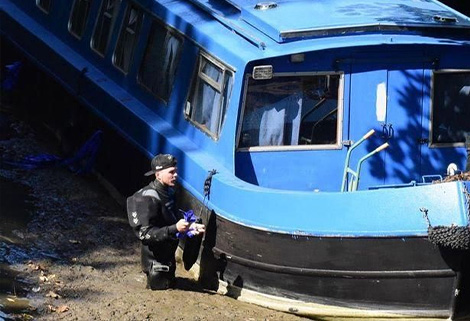
“Check river/canal conditions, and again consider whether the journey is really necessary; they can change quickly and easily catch you unaware. Get updates from the Environment Agency. Never head out when a river is in red flag.
“And be aware of the wind direction before manoeuvring. When coupled with difficult river conditions, the windage of a boat can be easily underestimated and your vessel will become uncontrollable.
“If a vessel is caught in a situation, do not attempt a recovery without assistance. Severe weather conditions increase the risk to boat owners and simple tasks can easily result in accidents and injury.
“Finally, check your insurance policy. As insurance companies try to minimise their exposure, an increasing number of third-party only policies exclude salvage and wreck removal - one of the biggest risks to boats.”
In October last year, the UK faced severe downpours and over the last weekend of the month there were 90 flood warnings and 120 flood alerts in place, putting huge pressure on boaters who were faced with suddenly rising and falling water levels.
You can find RCR on Facebook, visit their website, call 01785 785680 or email
it’s a blast!
it's a blast
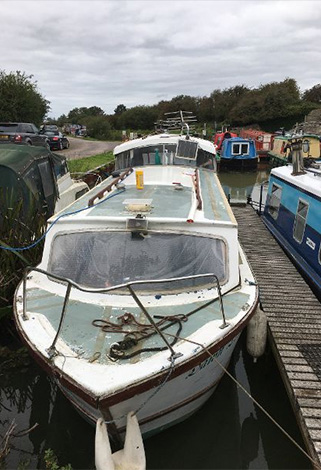
There is one major problem with Dawn Treader (DT) that has annoyed me since I bought it. It has crazing on the glass fibre. This is when the surface of the gel coat loos like smashed glass – and I suppose in a way it is. Confined mainly to the cabin roof and the decks, the internet has more causes and cures for this than the common cold. The most laborious cure being to ream out each crack with a Dremel and fill with gel coat and smooth, an option that would take me years on a 25-foot boat. Worse than that I know I simply don’t have the patience for that kind of thing.
What causes it seems less certain, it’s obviously down to aging by sunlight and / or the the gel coat mix. Originally DT was the sort of green best left on a 1970s colour chart and not revived as the darker colours absorb heat more. What ever the cause, the problem is six months after you paint it, it starts to resemble the cracking usually associated with an old master’s oil painting. Water gets under the paint and within six months to a year it's all peeling off.
The next issue is the cabin roof, this has had a hard life with me, kids, dinghies, canoes you name it, shoved on – Indeed about the only thing it hasn’t had is a Harrier jump jet land on it. Mainly because its flat. And there in lies my problem. I don’t think it has slumped it seems to have the same shallow curve as when it was built, but it doesn’t shed the water the same way some other craft do. The original design had only one support beam - Known to Dawncraft owners as 'the nutcracker' as you invariably whack your head on it. I’ve noticed this for a long time so actually installed some stiffeners, basically hard wood strips laminated and bolted in under the handrails from the inside. It stops some of the flexing but did little to improve the profile.
Ok - what I think is missing from modern life is the ability to utilise one process already proven to cure another problem. Also the ability to experiment , we rely too much on the internet for our salvation.
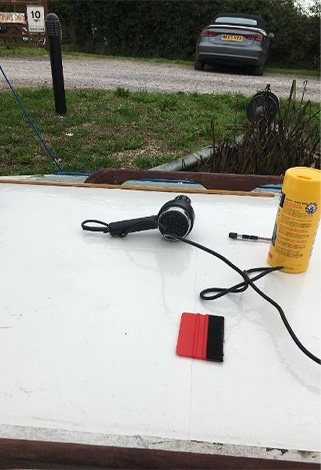
Basically, I have vinyl wrapped the roof in the same way they do custom cars. It’s a very 70s thing and an optional extra!!
First obviously sand back any rough bits and loose paint – remove all fittings and fixtures. None of which I could do because I resin them in to stop the leaks, you just have to work around it.
The trick is to work in small sheets, so I came across the deck and not along it if that makes sense. Tape down one end – the stuff wants to curl back on itself the moment you un roll it - leave your self some excess ( it trims easily) then dry the deck with a hair dryer – you need every last bit of moisture out those cracks and you want the deck slightly warm to help stick and off you go.
Once it's down, it's the same trick I used inside. Use a hair dryer and heat it up - you are trying to cause air bubbles which you can either smooth out or pop with a sharp knife. Once it cools and shrinks it looks smooth. Going around the air vents wasn’t as dramatic as I thought as it's so flexible. The effect is instant and fresh, and you soon get the hang of it. I did the whole lot in one afternoon.
Will it work on the outside? Of course, it will - as long as the vinyl has a reasonably good UV protection, after all they use it on cars, lorries etc and the vinyl graphics – a sort of Viking carving that some owner applied to my hull sides in 1990 are still very much evident (In the same lurid green). It works on DT because it is flat, working on anything with a full curve may be trickier but then they drain so don’t get the problem to start with.
As an engineer I was going to write a stunning article about E10 fuel and what it could do to your engine. But what with Covid, followed by climate crisis, fuel shortages and Xmas stuck in the China sea, who needs another doomsday scenario. Basically, E10 is more hydroscopic than E5 which means it attracts and absorbs water. It can corrode fuel pipes and carburettor rubbers. But then I sat down and realised something from years ago when common sense was in fashion: we changed these each year or so anyway, as part of what was known as a 'routine service'.
boating community supports vets afloat
boating community supports forces vets afloat
Inland waterway businesses and boat owners are coming together to help the newly-established Forces Vets Afloat Project restore a boat so it can be used and enjoyed by British forces veterans.
 Founder and boat owner Andy Flint set up the Project in July 2021, and with the support of River Canal Rescue, Ballinger Towage Services, Redhill Marina and volunteers, is on track to send its first boat to the Veterans Support Association (VSA).
Founder and boat owner Andy Flint set up the Project in July 2021, and with the support of River Canal Rescue, Ballinger Towage Services, Redhill Marina and volunteers, is on track to send its first boat to the Veterans Support Association (VSA).
The project began when Andy, a member of the abandoned boats group on Facebook, witnessed people arguing over rights of ownership and how to create the highest profit for the least investment. He posted a suggestion that rather than haggle over who could make the most from the boat, why not give it to a more deserving cause.
His feedback received 100+ likes and comments, and the consensus was to support ex-forces personnel. From there things snowballed; a member of the military, Lizzie Lane, offered to set up the Forces Vets Afloat Project on Facebook and within 24 hours it received 15,000 views.
 RCR’s rescue team co-ordinator, Tushka Horton, also messaged Andy, offering assistance and signposting him to Redhill Marina in Nottingham. As RCR takes its abandoned vessels there, she thought it would be a good place to source and restore a boat.
RCR’s rescue team co-ordinator, Tushka Horton, also messaged Andy, offering assistance and signposting him to Redhill Marina in Nottingham. As RCR takes its abandoned vessels there, she thought it would be a good place to source and restore a boat.
By day three, the site had 50,000 views and Andy was approached by Fran Vaughan, who offered to donate her parents’ 40ft narrowboat, Spencer’s Revenge. Her father Frank, had passed away, and the boat, moored at a marina on the Macclesfield Canal, needed some tlc.
The same day, ex-forces veteran Pete Ballinger messaged Andy volunteering his towing services. With help from Tushka and other volunteers, Pete travelled from Chepstow to Cheshire to pick up the boat and deliver it to the Marina on the River Soar.
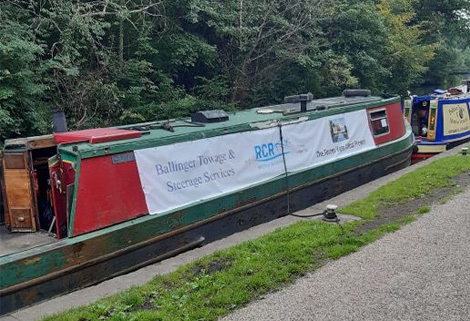 Tushka comments: “I was thrilled to be able to steer the boat and help with the lock at Great Haywood. All of us are so proud to be involved in this Project.”
Tushka comments: “I was thrilled to be able to steer the boat and help with the lock at Great Haywood. All of us are so proud to be involved in this Project.”
Graham Smeeton from Redhill Marina agrees: “When Tushka asked if we could provide a base for the Project’s donated boats, we were more than happy to help. All of us here, including marina owner Richard Morley, are proud to support those who have served our country.”
Spencer’s Revenge has been re-named Aurora and once restored, it will become a floating community hub for the VSA, supporting people with Post Traumatic Stress Disorder.
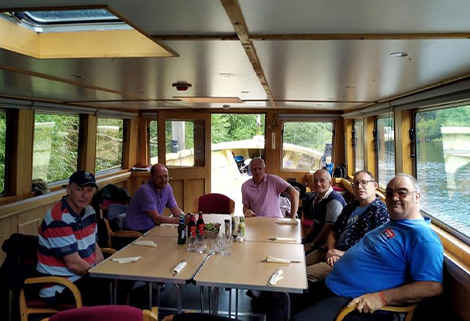 VSA founder John Joyce welcomes this new initiative, describing it as ‘the biggest new therapy’ for veterans: “In July, nine veterans went on a River Thames boat trip and we all found it so relaxing. I knew then I had to find a boat and soon after Andy contacted me. Fate certainly played a part!”
VSA founder John Joyce welcomes this new initiative, describing it as ‘the biggest new therapy’ for veterans: “In July, nine veterans went on a River Thames boat trip and we all found it so relaxing. I knew then I had to find a boat and soon after Andy contacted me. Fate certainly played a part!”
Fate appears to have been present since the start of the project. Andy lives close to Redhill Marina and Fran says the timing of her father’s passing is ‘too perfect to be a coincidence’. Both of Fran’s parents were in the military and having been left with a boat that needed work, she came across Andy’s donation request.
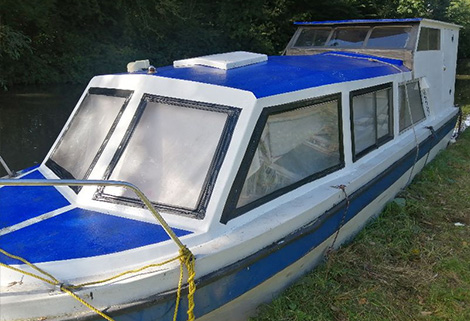 A second boat, a fibreglass Viking 23 moored on the Coventry canal, was donated by Keith Prosser in October, and in another quirk of fate, the inheritance of a 24ft sailboat from an unknown benefactor, influenced his decision. “I was given a boat by someone I didn’t know, so felt it only right to support the project and give ‘Canute’ to a veteran I don’t know.”
A second boat, a fibreglass Viking 23 moored on the Coventry canal, was donated by Keith Prosser in October, and in another quirk of fate, the inheritance of a 24ft sailboat from an unknown benefactor, influenced his decision. “I was given a boat by someone I didn’t know, so felt it only right to support the project and give ‘Canute’ to a veteran I don’t know.”
Andy continues: “The whole project is about utilising the skills and knowledge of businesses, boat owners, volunteers and the VSA, so we get boats to people who will really benefit from them.”
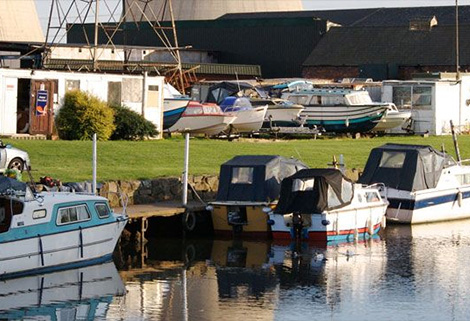
RCR is providing one year’s free membership for all boats donated, but the project also requires more business support and volunteers.
To find out more and make a donation, visit forces vets afloat website and click on more/want to help, send a message via Forces Vets Afloat on Facebook or WhatsApp, email or call 07956 082162.
new waterwatch initiative
new waterwatch safety and surveillance initiative
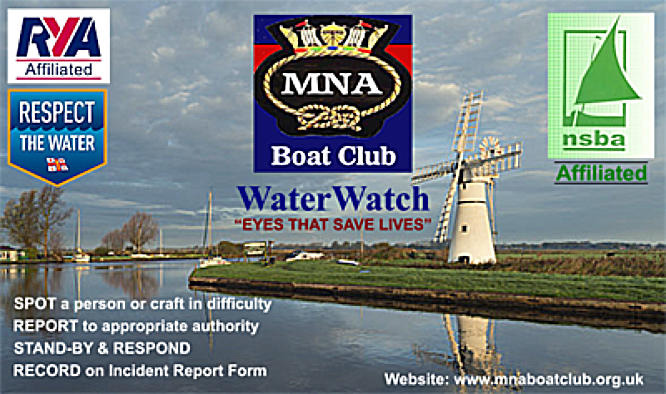
the initiative
- The WaterWatch Safety and Surveillance Initiative is committed to promoting the aims of the RNLI’s Respect the Water campaign to reduce the number of fatalities resulting from drowning on the coastal and inland waterways of the UK by utilising the experience of members of the Merchant Navy Association (MNA) Boat Club and other organisations with whom we have a partnership, such as the Norfolk & Suffolk Boating Association (NSBA) who promote WaterWatch on The Broads.
- Members of the MNA Boat Club and partner associations who volunteer to participate in WaterWatch, known as WaterWatch Crew Members, have an interest in, and a concern for, the safety of the increasing number of recreational boaters and other waterways users on and around our rivers, canals, lakes, Broads, coastal waters, harbours and marinas.
- WaterWatch Crew Members are experienced boaters and skilled observers who can be relied upon to spot potential incidents and hazards and respond with detailed information about the nature of the incident when reporting to HM Coastguard, to the appropriate inland waterways authority or other emergency services.
- WaterWatch Crew Members will inevitably come across incidents where immediate assistance is required before reporting the incident. In such circumstances members should always ensure that any action they take does not put themselves or any member of their crew in jeopardy.
- In most circumstances, having reported an incident to the appropriate authority, WaterWatch Crew Members will need to stand-by ready to assist the co-ordinating authority according to need. For example by maintaining a visual watch over the site of the incident, providing on-going situation reports, liaising between the co-ordinating authority and the rescue services, relaying messages and, where appropriate, by taking photographs..
- By participating in WaterWatch members will not only help to promote the RNLI’s Respect the Water campaign but also have the opportunity to develop and maintain good relationships with local stakeholders such as boatyards, marinas, the local navigational authority and local emergency services.
- WaterWatch volunteers will be part of a motivated and enthusiastic team having the opportunity and satisfaction of putting their boating experience and expertise to good use by helping to enhance safety on and around their local waters (perhaps even to the extent of helping to save a life), whilst protecting the boating environment and promoting responsible boating behaviour.
The MNA Boat Club is a member of the National Water Safety Forum.
members' checklist
Spot significant sightings of:
- People or craft in difficulty likely to require urgent assistance
- Unexpected hazards
- Dangerous or suspicious behaviour
- Behaviour threatening the boating environment (e.g. speeding & making a large wash)
Respond
If the incident appears to be life threatening requiring immediate action (such as pulling someone out of the water) WaterWatch Crew Members should of course render such assistance as they can manage without putting their own safety or that of their crew in jeopardy at any stage.
Report
- If the incident appears to be life threatening, requiring the assistance of the emergency services, WaterWatch Crew Members should contact the appropriate emergency service, such as HM Coastguard, by calling 999
- If the incident appears to be a criminal act in progress call 999 for the police
- For other significant Incidents contact the appropriate authority such as HM Coastguard or Local Navigational Authority direct
- In all cases Indicate:
- type of incident
- time of Incident
- precise location (GPS co-ordinate if possible)
- number of persons involved, including children and animals
- other pertinent information (e.g. persons wearing lifejackets)
- type of assistance required
Stand-By to further Respond if required
WaterWatch team members should:
- provide their name and contact details and advise the authorities of their activity as a member of the WaterWatch scheme before offering to assist by standing by at the scene (or elsewhere as directed)
- be prepared to provide a visual and/or listening watch and to monitor the situation and assist with liaison, relaying messages, providing up-dated situation reports (SITREPS) or other assistance as required.
- At no time should WaterWatch members put at risk their own lives or the lives of their crew
Record
WaterWatch team members should use the digital Incident Report form to submit a brief summary of the incident as quickly as possible after the incident has been terminated by the relevant authority, with a view to possibly being asked for a more detailed report at a later stage.
typical types of incidents responded to by members of the waterwatch crew
People (none wearing lifejackets) pulled from the water after falling off vessels on the Broads; in one case the vessel concerned had steamed away oblivious to the fact that they had a crew member missing!
Use of ladder fixed to the transom of our WaterWatch crew member's boat to recover another vulnerable person from the water before calling an ambulance
Standing by to assist broken-down craft, and escorting hire craft holed in a collision to the appropriate boat hire operator's base.
Alerting police and coastguards to incident involving theft of an expensive electric launch, subsequently recovered undamaged and miscreant arrested.
Use of boarding ladder to recover an elderly yachtsman who fell of the deck of his yacht into the river whilst hoisting sail.
Reporting to waterway authority several incidents of hire vessels speeding and/or helming without due care and attention, causing a danger to other craft.
Towing grounded craft into deeper water to re-float.
Standing by to assist Broads Authority Ranger’s launch to recover grounded hire cruiser .
chilligibbon’s stringed things
featured roving canal trader
Chris Hicks - chilligibbon's stringed things
We have been trading from the canal now for 5 years, albeit the last couple of years have been very quiet on the festival front! Karen, Ozzy dog and myself have been living aboard now for about 7 years, quickly progressing from our first small leisure boat to a 57ft liveaboard within about 18 months, having fallen in love with the lifestyle, surroundings and characters on the cut.
I am a keen amateur musician and have played bass guitar in a few local bands during my younger years but now am firmly set on the ukulele and enjoy playing with a ukulele group. Also we have many an impromptu jam session on the towpath or in the canalside pubs!
I had a 3 string guitar a few years ago that someone had made from an old whiskey tin, after a while I took it apart to make a few changes to it. This progressed to me doing some investigating into the history of cigar box guitars and then moving on to making myself a guitar from scratch from an old wooden cigar box. This turned out well, so I made another one, and another one!
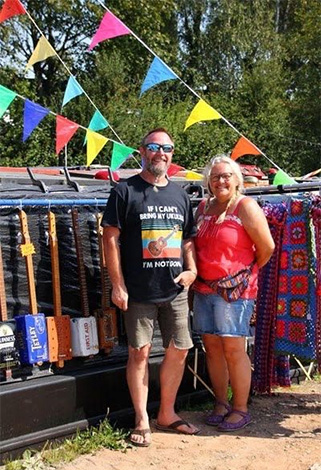
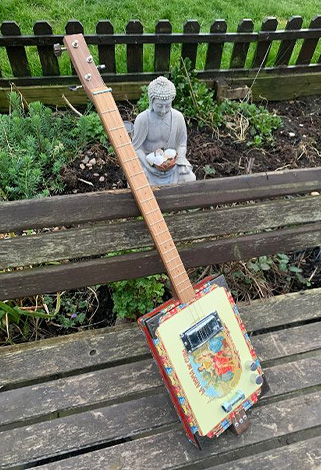
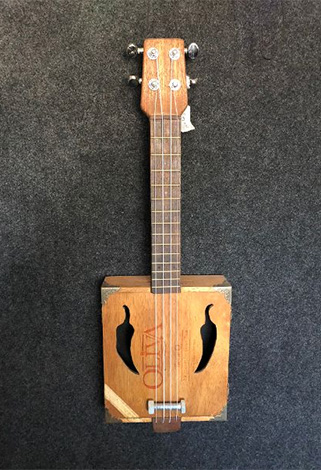
At this point I had a couple of friends on the canal asking if I would make them a guitar, so I did and one thing led to another and we ended up becoming roving traders so we could sell as and when we got the chance to travel and attend small Canal based festivals.
Initially I was making the instruments on the towpath with a few tools when the weather allowed, now I have an 8 x 6 shed on our mooring so have a little more comfort and room for a few more tools!
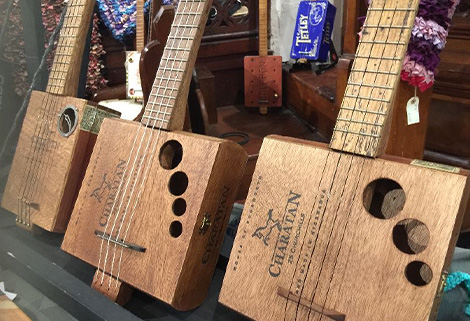

Every instrument looks and sounds different depending on the box or tin that you use, I started by searching eBay and junk shops and experimenting with anything that looked like it might work, now I get people giving me tins and boxes so have a good selection at the moment.
Once I had sussed the guitars, I started to make ukuleles as they are very popular at the moment. Both the guitars and ukuleles are fairly compact so make good boat instruments without taking up too much room.
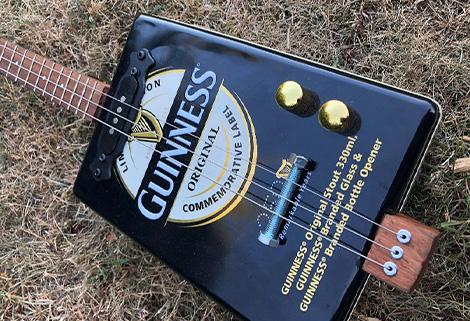
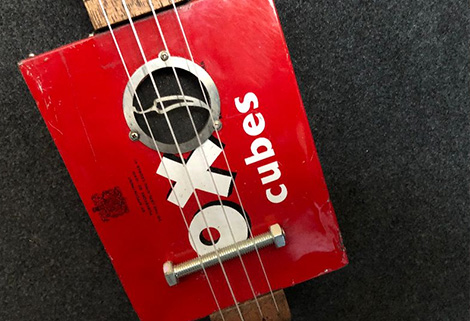
I tune my guitars to an open chord which means you can play with just one finger across all 3 strings on any fret and make a chord so it is easy to get a tune quickly for beginners but is also versatile enough for a more established player to use more complicated chords or play with a slide for a real bluesy feel.
I build instruments for stock and also will take commissions if a customer has a suitable box or tin that they would like converting.
Alongside the instruments, Karen makes crochet blankets, buntings, cushion covers and mushroom vent covers and also always has a good selection of her handmade rag rugs available when we are trading on the towpath or online.
Recently she has made matching blankets and cushions to finish off the décor in an historic back cabin and can make to order if you have something specific in mind.




How much fun can you have with an old box? Chris Hicks, trading as chilligibbon's stringed things, is the maker of Cigar Box and vintage tin guitars, ukuleles and other musical instruments. 'From First aid to Glenfiddich to Jacobs Crackers, we can make any tin of the right size into a great instrument.'
Visit Chris & Karen's Etsy shop, take a look at their website and follow them on Facebook.
